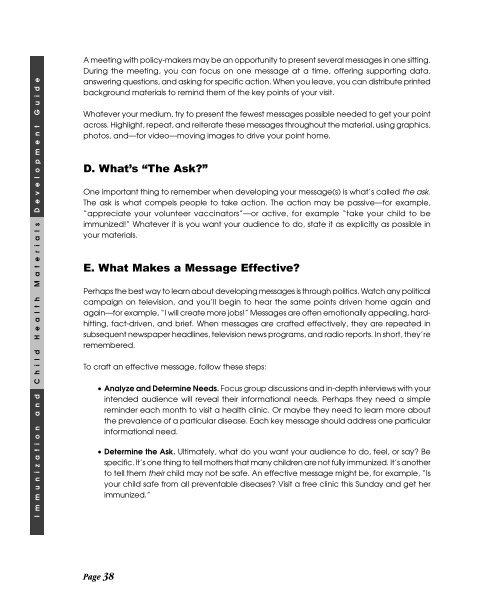Immunization and child health materials development guide pdf
Immunization and child health materials development guide pdf
Immunization and child health materials development guide pdf
You also want an ePaper? Increase the reach of your titles
YUMPU automatically turns print PDFs into web optimized ePapers that Google loves.
A meeting with policy-makers may be an opportunity to present several messages in one sitting.<br />
During the meeting, you can focus on one message at a time, offering supporting data,<br />
answering questions, <strong>and</strong> asking for specific action. When you leave, you can distribute printed<br />
background <strong>materials</strong> to remind them of the key points of your visit.<br />
Whatever your medium, try to present the fewest messages possible needed to get your point<br />
across. Highlight, repeat, <strong>and</strong> reiterate these messages throughout the material, using graphics,<br />
photos, <strong>and</strong>—for video—moving images to drive your point home.<br />
D. What’s “The Ask?”<br />
One important thing to remember when developing your message(s) is what’s called the ask.<br />
The ask is what compels people to take action. The action may be passive—for example,<br />
“appreciate your volunteer vaccinators”—or active, for example “take your <strong>child</strong> to be<br />
immunized!” Whatever it is you want your audience to do, state it as explicitly as possible in<br />
your <strong>materials</strong>.<br />
E. What Makes a Message Effective?<br />
Perhaps the best way to learn about developing messages is through politics. Watch any political<br />
campaign on television, <strong>and</strong> you’ll begin to hear the same points driven home again <strong>and</strong><br />
again—for example, “I will create more jobs!” Messages are often emotionally appealing, hardhitting,<br />
fact-driven, <strong>and</strong> brief. When messages are crafted effectively, they are repeated in<br />
subsequent newspaper headlines, television news programs, <strong>and</strong> radio reports. In short, they’re<br />
remembered.<br />
To craft an effective message, follow these steps:<br />
• Analyze <strong>and</strong> Determine Needs. Focus group discussions <strong>and</strong> in-depth interviews with your<br />
intended audience will reveal their informational needs. Perhaps they need a simple<br />
reminder each month to visit a <strong>health</strong> clinic. Or maybe they need to learn more about<br />
the prevalence of a particular disease. Each key message should address one particular<br />
informational need.<br />
• Determine the Ask. Ultimately, what do you want your audience to do, feel, or say? Be<br />
specific. It’s one thing to tell mothers that many <strong>child</strong>ren are not fully immunized. It’s another<br />
to tell them their <strong>child</strong> may not be safe. An effective message might be, for example, “Is<br />
your <strong>child</strong> safe from all preventable diseases? Visit a free clinic this Sunday <strong>and</strong> get her<br />
immunized.”<br />
Page 38

















